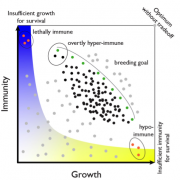Pearls review on plant immunity
Cooperation and conflict in the plant immune system.
Chae, E., Tran, D. T. N., and Weigel, D.
Plants have a sophisticated innate immune system with which they defend themselves against a myriad of pathogens. During the past two decades, work in a range of species has advanced our knowledge of the molecular and biochemical details of plant immunity. Many of these studies have focused on the action of nucleotide-binding domain/leucine-rich repeat (NB-LRR or NLR) immune receptors. NLR genes constitute the most diverse gene family in plants, reflecting their role in perceiving a very diverse set of molecules that are released by pathogens. There has also been progress in unraveling the forces that drive diversification of NLR and non-NLR immune receptors in wild species. A major recent insight from mechanistic and evolutionary studies is that there is both cooperation and conflict in the plant immune system. Here, we propose that these two antagonistic forces are inherently entangled, and that they are potentially fundamental to our understanding of growth-defense trade-offs.



